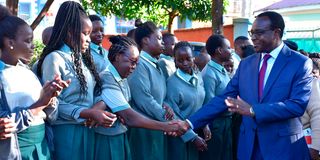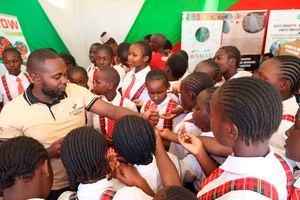
Cabinet Secretary for Education Julius Migos Ogamba shakes hands with JSS pupils during the official opening of JSS classrooms at Kakamega Primary School in Kakamega County on December 4, 2024.
When learners in Grade 9 select the senior schools they wish to join in January next year, the traditional categorisation of national, extra-county, county and sub-county schools will not be on offer.
Selection of senior schools will rather be according to the career pathways in the competency-based curriculum (CBC) that they offer. However, the Ministry of Education is yet to communicate to parents, learners and teachers the pathways that various secondary schools will offer.
Before the selection process begins, senior schools will declare them through respective county directors of education.
Stakeholders in the education sector are expected to debate draft guidelines on how learners will be placed to senior school after the Cabinet Secretary for Education Julius Ogamba launches the public participation process on Friday.
According to the guidelines, senior schools will be categorised as either triple pathways or double pathways. Triple pathway schools will offer all three pathways on offer. These are science, technology, engineering and mathematics (STEM), Arts and Sports Science, and Social Sciences. It is expected that these are schools with adequate physical and human resources to offer a wide range of learning areas. Double pathway senior schools will offer just two of the three pathways.
However, there will be flexibility for learners to transfer between various pathways if their interests, abilities, or career aspirations change along the way. The guidelines propose that enrolment per senior school should be capped at 3,000 learners.
In the CBC set-up, senior school will comprise Grades 10, 11 and 12 and is the last segment of basic education. At the end of Grade 9, learners will undertake the Kenya Junior School Education Assessment (KJSEA). The pioneer CBC class will undertake their assessment in October and November this year.
During placement, learners who miss places in schools of their choice will be placed in schools offering the pathway and subject combination of their choice.
The tracks for STEM are pure science, applied science and technical studies. The arts and sports science pathway will have arts and sports science as its tracks whereas the social science pathway will have the following tracks: language and literature, humanities and business.
Triple pathway schools are expected to be in high demand because they will admit the top performers in the KJSEA. These will be: the top two candidates per gender in each STEM track per sub-county, one top candidate per gender in each social science track per sub-county and the top candidate per gender in each arts and sports science track per sub-county.
After fulfilling the above criteria, the rest of the learners in a triple pathway senior school will be placed by merit and choice. The Ministry of Education will also employ quotas to ensure equity through regional spread. The type of junior school (public or private) will also be applied.
“I don’t think there is any child or any parent who wants their child to go to a current sub-county school to study STEM, so we are going to really heighten competition for the very few good schools that are capable of offering that pathway,” said “Dr Emmanuel Manyasa, the executive director of USAWA Agenda.

Usawa Agenda Executive Director Emmanuel Manyasa during the launch of another report at Kenya Institute of Curriculum Development in Nairobi
“This statement of balancing to ensure equity is a confession that many other schools will not be offering learners opportunities to achieve their full potential,” he added.
Learners who will miss out on placement to triple pathways senior schools will be placed in Double Pathways Senior Schools. Their placement will be based on the choice of pathways and subject combinations, performance, choice of boarding or day, and capacity of the schools.
Complainants regarding placement will be channelled through heads of institutions of respective junior schools who will fill out a prescribed form and forward it to the county directors of education. This should be done at least two weeks before the official reporting date for Grade 10 learners.
“It means the head of your current junior school will determine whether to forward your appeal or not. Either deliberately or because they’re overwhelmed with assignments, they may fail to submit your appeal and that becomes a bottleneck to the appeal process,” observed Dr Manyasa.





